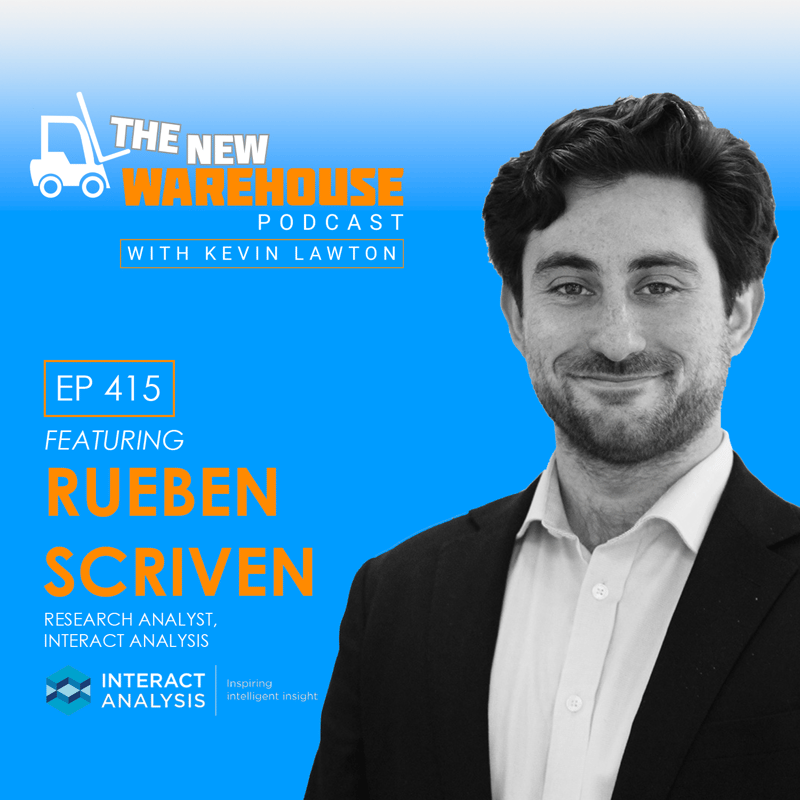
Episode 415: Navigating the Future of Warehouse Automation with Rueben Scriven of Interact Analysis
For this episode of The New Warehouse, we have the pleasure of hosting Rueben Scriven, Research Manager at Interact Analysis, an organization at the forefront of market intelligence for supply chain automation. Rueben delves deep into what’s happening in the warehouse automation market, the dynamics of orchestration platforms, and the emerging trends shaping the future. From the big behemoths like Amazon to small and medium enterprises (SMEs), automation touches every facet of the supply chain. This episode offers a treasure trove of insights for anyone invested in warehousing, so you don’t want to miss it.
The Current State of the Warehouse – The Interact Analysis Perspective
The warehouse, often seen as the backbone of the supply chain, has undergone a remarkable transformation over the past few years. According to Rueben, we’re at an interesting crossroads in 2023.
- Surge and Slowdown – The initial pandemic-induced boom in e-commerce led to a surge in new, large-scale automated warehouses. However, as interest rates rise and e-commerce growth stabilizes, new warehouse construction is slowing down and is expected to decline by 35% in 2023 compared to 2022.
- Focus on Efficiency – Rather than building new facilities, operators are now more interested in maximizing the efficiency of existing warehouses. This has increased demand for point solutions or automation technologies that solve specific operational challenges.
- The Rise of Modular Systems – Technological advancements have developed more modular systems. The separation between Original Equipment Manufacturers (OEMs) and system integrators is becoming increasingly prominent as fast-paced technological developments have led to partnerships to harness both strengths.
- SMEs Entering the Fray – While large corporations have been the traditional investors in warehouse automation, there’s a significant uptick in smaller and medium-sized businesses embracing automation. Innovative financial models like “Robotics-as-a-Service” (RaaS) and leasing options are making it more accessible for them.
- The American vs. European Landscape – While the U.S. market is highly concentrated, with the top eight investors accounting for more than 55% of automation investments, the European market presents a more diversified landscape.
The bottom line? The warehouse of the future is undergoing a seismic shift. It’s not just about size or scale; it’s about innovative, efficient, and flexible operations.
A Deep Dive into Labor Trends, ROI Shifts, and Software-Centric Strategies
Automation is not just a buzzword; it’s a necessity. Staying ahead means understanding the latest trends, technologies, and market shifts in today’s rapidly evolving supply chain landscape. The increasing integration of robotics and automation within warehouses has led to discussions around the return on investment (ROI) and the impact of labor availability on operations.
- Labor Availability and ROI Shift – The focus shifted from traditional ROI calculations to labor availability during the pandemic. With labor becoming scarcer due to various factors, warehouse operators were more concerned with maintaining operations than optimizing cost savings. Rather than seeking immediate cost savings, warehouse operators placed a premium on ensuring that operations could continue unfettered. Rueben believes, “ROI became less of a factor, and continuing operations became the central thesis of investing in automation.”
- Labor Trends – The conversation also touched on labor trends, highlighting the dramatic increase in warehouse labor during the pandemic, followed by expectations of gradual declines and fluctuations in the coming years. Rueben adds, “During the pandemic, warehouse labor in the U.S. nearly doubled, going from 1.3-1.4 million to an increase of about a million. We expect a decline of 200,000 FTEs in 2023, things to remain flat in 2024, followed by a significant increase of 250,000 FTEs in 2025.” This labor availability dynamic plays a role in shaping automation adoption strategies.
- Software’s Role in Automation – While the visual impact of automation hardware is striking, the conversation underlines that software is at the core of automation systems. Software, specifically WES, is vital for coordinating and optimizing the movement of goods through automated systems. This shift in perspective from pure hardware to software-centric approaches highlights the importance of intelligent decision-making in warehouse operations. Rueben believes, “At the end of the day, the value of your software you generate is how intelligent it is. It’s how many decisions your software makes. The more decisions your software makes, the more intelligent it is, the more valuable it is, and the more profitable it is.”
ROI: Don’t Call it a Comeback
Rueben revealed an emerging trend. “ROI is creeping back into the picture,” he explains. While the urgency of labor availability reshaped ROI considerations, the tide seems to be shifting once again. Rueben shares, “Companies are still looking at how do I continue my operations, but they want to do so in a cost-effective way.” The pendulum swings back, albeit with an altered perspective on what constitutes a justifiable ROI.
Rueben’s nuanced assessment points to a potential turning point. “We’re at a correction or a year,” he states, cautioning against viewing the shift as a mere return to pre-pandemic norms. The recalibration of ROI thresholds suggests a new era where companies are willing to invest more to embrace automation’s benefits. This metamorphosis prompts intriguing reflections on the ROI concept—what it means, what it means now, and the evolving strategies it shapes.
Key Takeaways from Interact Analysis
- Automation, the Future’s Imperative: Understanding warehouse automation trends is crucial in a rapidly evolving supply chain landscape. Interact Analysis provides insights into the integration of robotics, ROI shifts, and labor dynamics, shaping the future of warehousing.
- Labor Dynamics and ROI: Labor availability now drives automation investment. Pandemic-induced labor shortages shifted the focus from traditional ROI calculations to ensuring operational continuity.
- Software’s Vital Role: Automation’s core lies in software, especially Warehouse Execution Systems (WES). Embrace software-centric strategies for intelligent decision-making.
The New Warehouse Podcast
EP 415: Navigating the Future of Warehouse Automation with Rueben Scriven of Interact Analysis









